steering Seat Ibiza 5D 2008 Owner's manual
[x] Cancel search | Manufacturer: SEAT, Model Year: 2008, Model line: Ibiza 5D, Model: Seat Ibiza 5D 2008Pages: 260, PDF Size: 8.11 MB
Page 5 of 260
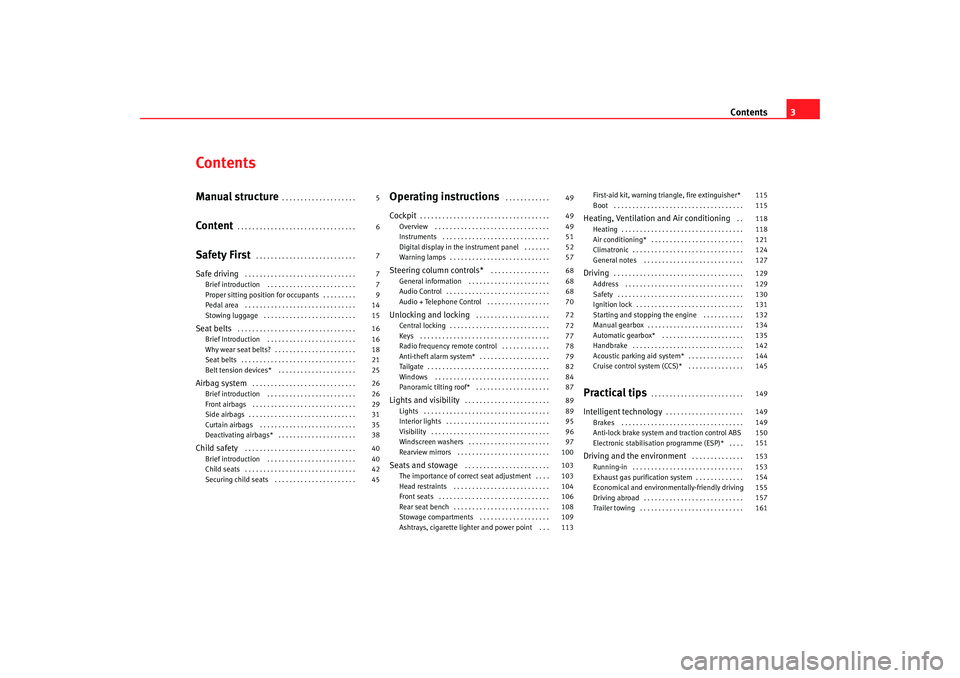
Contents3
ContentsManual structure
. . . . . . . . . . . . . . . . . . . .
Content
. . . . . . . . . . . . . . . . . . . . . . . . . . . . . . . .
Safety First
. . . . . . . . . . . . . . . . . . . . . . . . . . .
Safe driving
. . . . . . . . . . . . . . . . . . . . . . . . . . . . . .
Brief introduction . . . . . . . . . . . . . . . . . . . . . . . .
Proper sitting position for occupants . . . . . . . . .
Pedal area . . . . . . . . . . . . . . . . . . . . . . . . . . . . . .
Stowing luggage . . . . . . . . . . . . . . . . . . . . . . . . .
Seat belts
. . . . . . . . . . . . . . . . . . . . . . . . . . . . . . . .
Brief Introduction . . . . . . . . . . . . . . . . . . . . . . . .
Why wear seat belts? . . . . . . . . . . . . . . . . . . . . . .
Seat belts . . . . . . . . . . . . . . . . . . . . . . . . . . . . . . .
Belt tension devices* . . . . . . . . . . . . . . . . . . . . .
Airbag system
. . . . . . . . . . . . . . . . . . . . . . . . . . . .
Brief introduction . . . . . . . . . . . . . . . . . . . . . . . .
Front airbags . . . . . . . . . . . . . . . . . . . . . . . . . . . .
Side airbags . . . . . . . . . . . . . . . . . . . . . . . . . . . . .
Curtain airbags . . . . . . . . . . . . . . . . . . . . . . . . . .
Deactivating airbags* . . . . . . . . . . . . . . . . . . . . .
Child safety
. . . . . . . . . . . . . . . . . . . . . . . . . . . . . .
Brief introduction . . . . . . . . . . . . . . . . . . . . . . . .
Child seats . . . . . . . . . . . . . . . . . . . . . . . . . . . . . .
Securing child seats . . . . . . . . . . . . . . . . . . . . . .
Operating instructions
. . . . . . . . . . . .
Cockpit
. . . . . . . . . . . . . . . . . . . . . . . . . . . . . . . . . . .
Overview . . . . . . . . . . . . . . . . . . . . . . . . . . . . . . .
Instruments . . . . . . . . . . . . . . . . . . . . . . . . . . . . .
Digital display in the instrument panel . . . . . . .
Warning lamps . . . . . . . . . . . . . . . . . . . . . . . . . . .
Steering column controls*
. . . . . . . . . . . . . . . .
General information . . . . . . . . . . . . . . . . . . . . . .
Audio Control . . . . . . . . . . . . . . . . . . . . . . . . . . . .
Audio + Telephone Control . . . . . . . . . . . . . . . . .
Unlocking and locking
. . . . . . . . . . . . . . . . . . . .
Central locking . . . . . . . . . . . . . . . . . . . . . . . . . . .
Keys . . . . . . . . . . . . . . . . . . . . . . . . . . . . . . . . . . .
Radio frequency remote control . . . . . . . . . . . . .
Anti-theft alarm system* . . . . . . . . . . . . . . . . . . .
Tailgate . . . . . . . . . . . . . . . . . . . . . . . . . . . . . . . . .
Windows . . . . . . . . . . . . . . . . . . . . . . . . . . . . . . .
Panoramic tilting roof* . . . . . . . . . . . . . . . . . . . .
Lights and visibility
. . . . . . . . . . . . . . . . . . . . . . .
Lights . . . . . . . . . . . . . . . . . . . . . . . . . . . . . . . . . .
Interior lights . . . . . . . . . . . . . . . . . . . . . . . . . . . .
Visibility . . . . . . . . . . . . . . . . . . . . . . . . . . . . . . . .
Windscreen washers . . . . . . . . . . . . . . . . . . . . . .
Rearview mirrors . . . . . . . . . . . . . . . . . . . . . . . . .
Seats and stowage
. . . . . . . . . . . . . . . . . . . . . . .
The importance of correct seat adjustment . . . .
Head restraints . . . . . . . . . . . . . . . . . . . . . . . . . .
Front seats . . . . . . . . . . . . . . . . . . . . . . . . . . . . . .
Rear seat bench . . . . . . . . . . . . . . . . . . . . . . . . . .
Stowage compartments . . . . . . . . . . . . . . . . . . .
Ashtrays, cigarette lighter and power point . . . First-aid kit, warning triangle, fire extinguisher*
Boot . . . . . . . . . . . . . . . . . . . . . . . . . . . . . . . . . . .
Heating, Ventilation and Air conditioning
. .
Heating . . . . . . . . . . . . . . . . . . . . . . . . . . . . . . . . .
Air conditioning* . . . . . . . . . . . . . . . . . . . . . . . . .
Climatronic . . . . . . . . . . . . . . . . . . . . . . . . . . . . . .
General notes . . . . . . . . . . . . . . . . . . . . . . . . . . .
Driving
. . . . . . . . . . . . . . . . . . . . . . . . . . . . . . . . . . .
Address . . . . . . . . . . . . . . . . . . . . . . . . . . . . . . . .
Safety . . . . . . . . . . . . . . . . . . . . . . . . . . . . . . . . . .
Ignition lock . . . . . . . . . . . . . . . . . . . . . . . . . . . . .
Starting and stopping the engine . . . . . . . . . . .
Manual gearbox . . . . . . . . . . . . . . . . . . . . . . . . . .
Automatic gearbox* . . . . . . . . . . . . . . . . . . . . . .
Handbrake . . . . . . . . . . . . . . . . . . . . . . . . . . . . . .
Acoustic parking aid system* . . . . . . . . . . . . . . .
Cruise control system (CCS)* . . . . . . . . . . . . . . .
Practical tips
. . . . . . . . . . . . . . . . . . . . . . . . .
Intelligent technology
. . . . . . . . . . . . . . . . . . . . .
Brakes . . . . . . . . . . . . . . . . . . . . . . . . . . . . . . . . .
Anti-lock brake system and traction control ABS
Electronic stabilisation programme (ESP)* . . . .
Driving and the environment
. . . . . . . . . . . . . .
Running-in . . . . . . . . . . . . . . . . . . . . . . . . . . . . . .
Exhaust gas purification system . . . . . . . . . . . . .
Economical and environmentally-friendly driving
Driving abroad . . . . . . . . . . . . . . . . . . . . . . . . . . .
Trailer towing . . . . . . . . . . . . . . . . . . . . . . . . . . . .
5
6
7
7
7
9
14
15
16
16
18
21
25
26
26
29
31
35
38
40
40
42
45 49
49
49
51
52
57
68
68
68
70
72
72
77
78
79
82
84
87
89
89
95
96
97
100
103
103
104
106
108
109
113 115
115
118
118
121
124
127
129
129
130
131
132
134
135
142
144
145
149
149
149
150
151
153
153
154
155
157
161
Ibiza250_angles Seite 3 Dienstag, 5. August 2008 1:11 13
Page 9 of 260
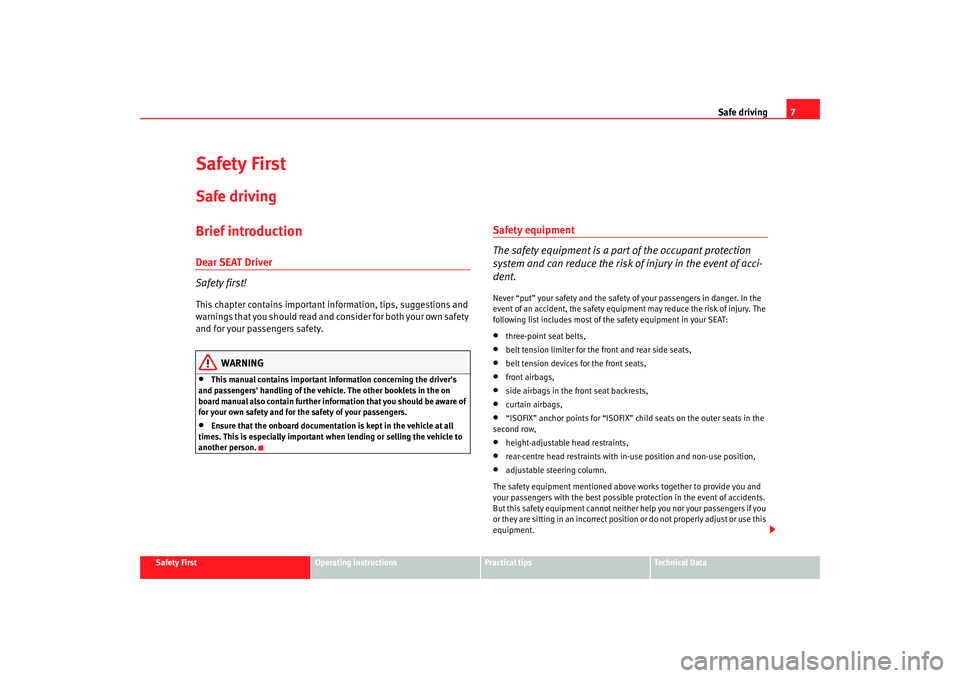
Safe driving7
Safety First
Operating instructions
Practical tips
Te c h n i c a l D a t a
Safety FirstSafe drivingBrief introductionDear SEAT Driver
Safety first!This chapter contains important information, tips, suggestions and
warnings that you should read and consider for both your own safety
and for your passengers safety.
WARNING
•
This manual contains important info rmation concerning the driver's
and passengers' handling of the vehicle. The other booklets in the on
board manual also contain further information that you should be aware of
for your own safety and for the safety of your passengers.
•
Ensure that the onboard documentatio n is kept in the vehicle at all
times. This is especially important when lending or selling the vehicle to
another person.
Safety equipment
The safety equipment is a part of the occupant protection
system and can reduce the risk of injury in the event of acci-
dent.Never “put” your safety and the safety of your passengers in danger. In the
event of an accident, the safety equipment may reduce the risk of injury. The
following list includes most of the safety equipment in your SEAT:•
three-point seat belts,
•
belt tension limiter for the front and rear side seats,
•
belt tension devices for the front seats,
•
front airbags,
•
side airbags in the front seat backrests,
•
curtain airbags,
•
“ISOFIX” anchor points fo r “ISOFIX” child seats on the outer seats in the
second row,
•
height-adjustable head restraints,
•
rear-centre head restraints with in-use position and non-use position,
•
adjustable steering column.
The safety equipment mentioned above works together to provide you and
your passengers with the best possible protection in the event of accidents.
But this safety equipment cannot neither help you nor your passengers if you
or they are sitting in an incorrect position or do not properly adjust or use this
equipment.
Ibiza250_angles Seite 7 Dienstag, 5. August 2008 1:11 13
Page 11 of 260

Safe driving9
Safety First
Operating instructions
Practical tips
Te c h n i c a l D a t a
– When travelling long distances, take breaks regularly - at least
every two hours.
– If possible, avoid driving when you are tired or are in tension.
WARNING
When driving safety is impaired during a trip, the risk of injury and acci-
dents increases.Proper sitting position for occupantsProper sitting position for driver
The proper sitting position for the driver is important for a
safe and relaxed driving.
For your own safety and to reduce the risk of injury in the event of an
accident, we recommend the following adjustments for the driver:
– Adjust the steering wheel so that there is a distance of at least
25 cm between the steering wheel and the centre of your chest
⇒ fig. 1.
– Move the driver's seat forwards or backwards so that you are able to press the accelerator, brake and clutch pedals to the floor with
your knees still slightly angled ⇒.
– Ensure that you can reach the highest point of the steering wheel.
– Adjust the head restraint so that its upper edge is at the same level as the top of your head, or as close as possible to the same
level as the top of your head ⇒fig. 2.
– Move the backrest to an upright position so that your back rests completely against it.
Fig. 1 The proper
distance between driver
and steering wheel
Fig. 2 Proper head
restraint position for
driver
Ibiza250_angles Seite 9 Dienstag, 5. August 2008 1:11 13
Page 12 of 260
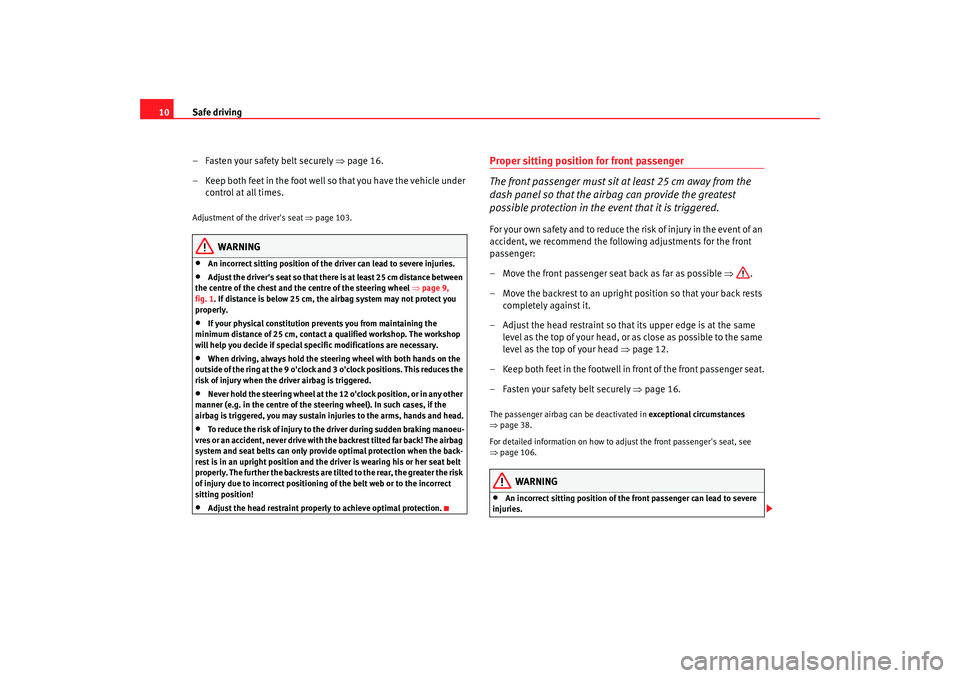
Safe driving
10
– Fasten your safety belt securely ⇒page 16.
– Keep both feet in the foot well so that you have the vehicle under control at all times.Adjustment of the driver's seat ⇒page 103.
WARNING
•
An incorrect sitting position of the driver can lead to severe injuries.
•
Adjust the driver's seat so that the re is at least 25 cm distance between
the centre of the chest and the centre of the steering wheel ⇒ page 9,
fig. 1 . If distance is below 25 cm, the airbag system may not protect you
properly.
•
If your physical constitution prevents you from maintaining the
minimum distance of 25 cm, contact a qualified workshop. The workshop
will help you decide if special specific modifications are necessary.
•
When driving, always hold the steer ing wheel with both hands on the
outside of the ring at the 9 o'clock and 3 o'clock positions. This reduces the
risk of injury when the driver airbag is triggered.
•
Never hold the steering wheel at the 12 o'clock position, or in any other
manner (e.g. in the centre of the stee ring wheel). In such cases, if the
airbag is triggered, you may sustain injuries to the arms, hands and head.
•
To reduce the risk of injury to the driver during sudden braking manoeu-
vres or an accident, never drive with the backrest tilted far back! The airbag
system and seat belts can only provide optimal protection when the back-
rest is in an upright position and the dr iver is wearing his or her seat belt
properly. The further the backrests are ti lted to the rear, the greater the risk
of injury due to incorrect positioning of the belt web or to the incorrect
sitting position!
•
Adjust the head restraint properly to achieve optimal protection.
Proper sitting position for front passenger
The front passenger must sit at least 25 cm away from the
dash panel so that the airbag can provide the greatest
possible protection in the event that it is triggered.For your own safety and to reduce the risk of injur y in the event of an
accident, we recommend the following adjustments for the front
passenger:
– Move the front passenger seat back as far as possible ⇒.
– Move the backrest to an upright position so that your back rests completely against it.
– Adjust the head restraint so that its upper edge is at the same level as the top of your head, or as close as possible to the same
level as the top of your head ⇒page 12.
– Keep both feet in the footwell in front of the front passenger seat.
– Fasten your safety belt securely ⇒page 16.The passenger airbag can be deactivated in exceptional circumstances
⇒ page 38.
For detailed information on how to adjust the front passenger's seat, see
⇒ page 106.
WARNING
•
An incorrect sitting position of the front passenger can lead to severe
injuries.
Ibiza250_angles Seite 10 Dienstag, 5. August 2008 1:11 13
Page 21 of 260
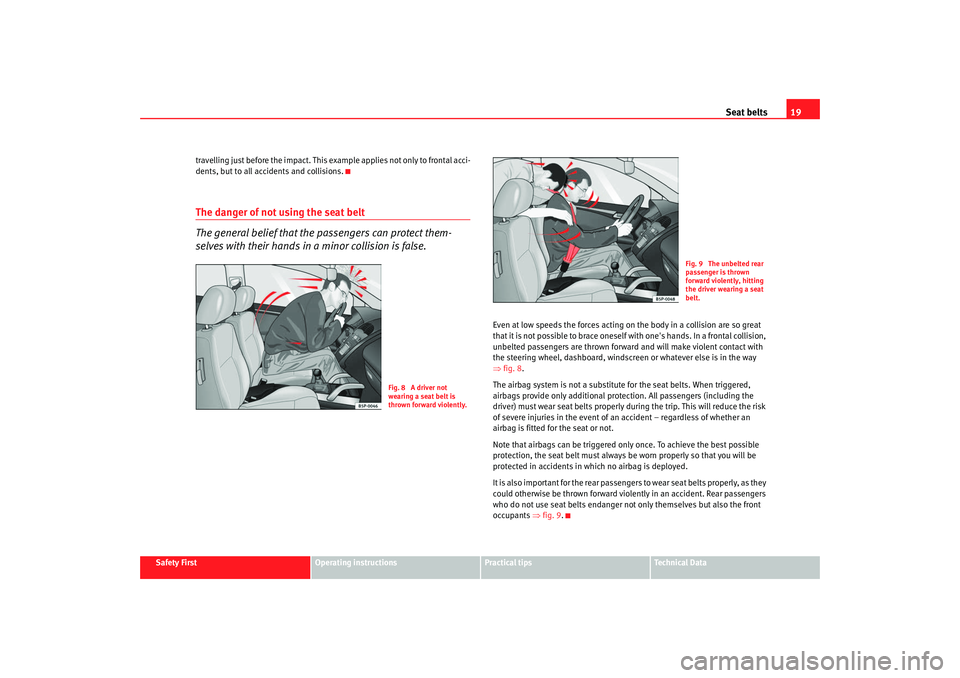
Seat belts19
Safety First
Operating instructions
Practical tips
Te c h n i c a l D a t a
travelling just before the impact. This example applies not only to frontal acci-
dents, but to all accidents and collisions.
The danger of not using the seat belt
The general belief that the passengers can protect them-
selves with their hands in a minor collision is false.
Even at low speeds the forces acting on the body in a collision are so great
that it is not possible to brace oneself with one's hands. In a frontal collision,
unbelted passengers are thrown forward and will make violent contact with
the steering wheel, dashboard, windscreen or whatever else is in the way
⇒
fig. 8 .
The airbag system is not a substitute for the seat belts. When triggered,
airbags provide only additional protection. All passengers (including the
driver) must wear seat belts properly duri ng the trip. This will reduce the risk
of severe injuries in the event of an accident – regardless of whether an
airbag is fitted for the seat or not.
Note that airbags can be triggered only once. To achieve the best possible
protection, the seat belt must always be worn properly so that you will be
protected in accidents in which no airbag is deployed.
It is also important for the rear passengers to wear seat belts properly, as they
could otherwise be thrown forward viole ntly in an accident. Rear passengers
who do not use seat belts endanger no t only themselves but also the front
occupants ⇒fig. 9.
Fig. 8 A driver not
wearing a seat belt is
thrown forward violently.
Fig. 9 The unbelted rear
passenger is thrown
forward violently, hitting
the driver wearing a seat
belt.
Ibiza250_angles Seite 19 Dienstag, 5. August 2008 1:11 13
Page 28 of 260
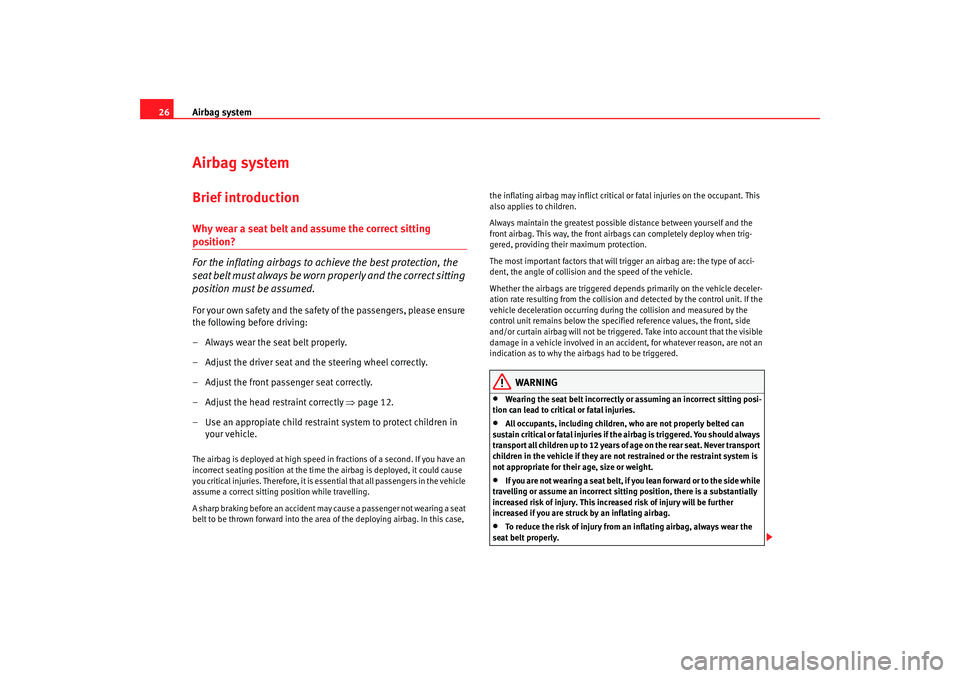
Airbag system
26Airbag systemBrief introductionWhy wear a seat belt and assume the correct sitting position?
For the inflating airbags to achieve the best protection, the
sea t b el t m u st al w ay s b e w o rn p ro p e rly a nd t h e co rrec t s i tt i n g
position must be assumed.For your own safety and the safety of the passengers, please ensure
the following before driving:
– Always wear the seat belt properly.
– Adjust the driver seat and the steering wheel correctly.
– Adjust the front passenger seat correctly.
– Adjust the head restraint correctly ⇒page 12.
– Use an appropiate child restraint system to protect children in your vehicle.The airbag is deployed at high speed in fractions of a second. If you have an
incorrect seating position at the time the airbag is deployed, it could cause
you critical injuries. Therefore, it is essential that all passengers in the vehicle
assume a correct sitting position while travelling.
A sharp braking before an accident may cause a passenger not wearing a seat
belt to be thrown forward into the area of the deploying airbag. In this case, the inflating airbag may inflict critical or fatal injuries on the occupant. This
also applies to children.
Always maintain the greatest possible distance between yourself and the
front airbag. This way, the front airbags can completely deploy when trig-
gered, providing their maximum protection.
The most important factors that will trigger an airbag are: the type of acci-
dent, the angle of collision and the speed of the vehicle.
Whether the airbags are triggered depends primarily on the vehicle deceler-
ation rate resulting from the collision an
d detected by the control unit. If the
vehicle deceleration occurring duri ng the collision and measured by the
control unit remains below the specifie d reference values, the front, side
and/or curtain airbag will not be triggered. Take into account that the visible
damage in a vehicle involved in an accident, for whatever reason, are not an
indication as to why the airbags had to be triggered.
WARNING
•
Wearing the seat belt incorrectly or assuming an incorrect sitting posi-
tion can lead to critical or fatal injuries.
•
All occupants, including children, who are not properly belted can
sustain critical or fatal injuries if the airbag is triggered. You should always
transport all children up to 12 years of age on the rear seat. Never transport
children in the vehicle if they are not restrained or the restraint system is
not appropriate for their age, size or weight.
•
If you are not wearing a seat belt, if you lean forward or to the side while
travelling or assume an incorrect sitting position, there is a substantially
increased risk of injury. This increased risk of injury will be further
increased if you are struck by an inflating airbag.
•
To reduce the risk of injury from an inflating airbag, always wear the
seat belt properly.
Ibiza250_angles Seite 26 Dienstag, 5. August 2008 1:11 13
Page 30 of 260
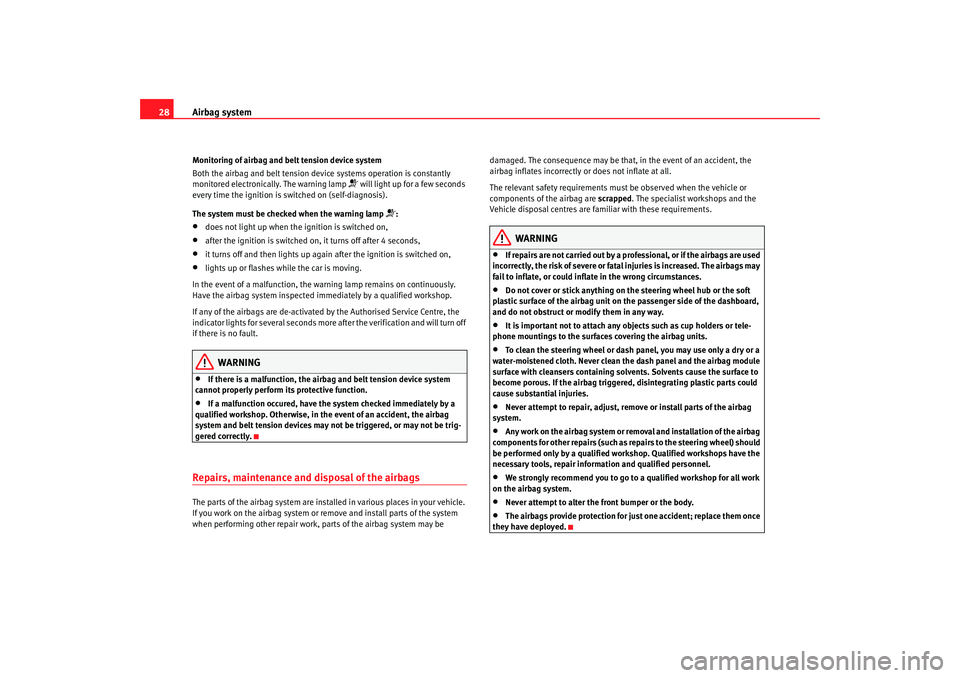
Airbag system
28Monitoring of airbag and belt tension device system
Both the airbag and belt tension device systems operation is constantly
monitored electronically. The warning lamp
will light up for a few seconds
every time the ignition is switched on (self-diagnosis).
The system must be checked when the warning lamp
:
•
does not light up when the ignition is switched on,
•
after the ignition is switched on, it turns off after 4 seconds,
•
it turns off and then lights up again after the ignition is switched on,
•
lights up or flashes while the car is moving.
In the event of a malfunction, the warning lamp remains on continuously.
Have the airbag system inspected immediately by a qualified workshop.
If any of the airbags are de-activated by the Authorised Service Centre, the
indicator lights for several seconds more after the veri fication and will turn off
if there is no fault.
WARNING
•
If there is a malfunction, the air bag and belt tension device system
cannot properly perform its protective function.
•
If a malfunction occured, have the system checked immediately by a
qualified workshop. Otherwise, in the event of an accident, the airbag
system and belt tension devices may no t be triggered, or may not be trig-
gered correctly.
Repairs, maintenance and disposal of the airbagsThe parts of the airbag system are installed in various places in your vehicle.
If you work on the airbag system or remove and install parts of the system
when performing other repair work, parts of the airbag system may be damaged. The consequence may be that, in the event of an accident, the
airbag inflates incorrectly
or does not inflate at all.
The relevant safety requirements must be observed when the vehicle or
components of the airbag are scrapped. The specialist workshops and the
Vehicle disposal centres are familiar with these requirements.
WARNING
•
If repairs are not carried out by a professional, or if the airbags are used
incorrectly, the risk of severe or fatal injuries is increased. The airbags may
fail to inflate, or could inflate in the wrong circumstances.
•
Do not cover or stick anything on the steering wheel hub or the soft
plastic surface of the airbag unit on the passenger side of the dashboard,
and do not obstruct or modify them in any way.
•
It is important not to attach any objects such as cup holders or tele-
phone mountings to the surfaces covering the airbag units.
•
To clean the steering wheel or dash panel, you may use only a dry or a
water-moistened cloth. Never clean the dash panel and the airbag module
surface with cleansers containing solvents. Solvents cause the surface to
become porous. If the airbag trigger ed, disintegrating plastic parts could
cause substantial injuries.
•
Never attempt to repair, adjust, remove or install parts of the airbag
system.
•
Any work on the airbag system or re moval and installation of the airbag
components for other repairs (such as repairs to the steering wheel) should
be performed only by a qualified workshop. Qualified workshops have the
necessary tools, repair information and qualified personnel.
•
We strongly recommend you to go to a qualified workshop for all work
on the airbag system.
•
Never attempt to alter the front bumper or the body.
•
The airbags provide protection for just one accident; replace them once
they have deployed.
Ibiza250_angles Seite 28 Dienstag, 5. August 2008 1:11 13
Page 31 of 260
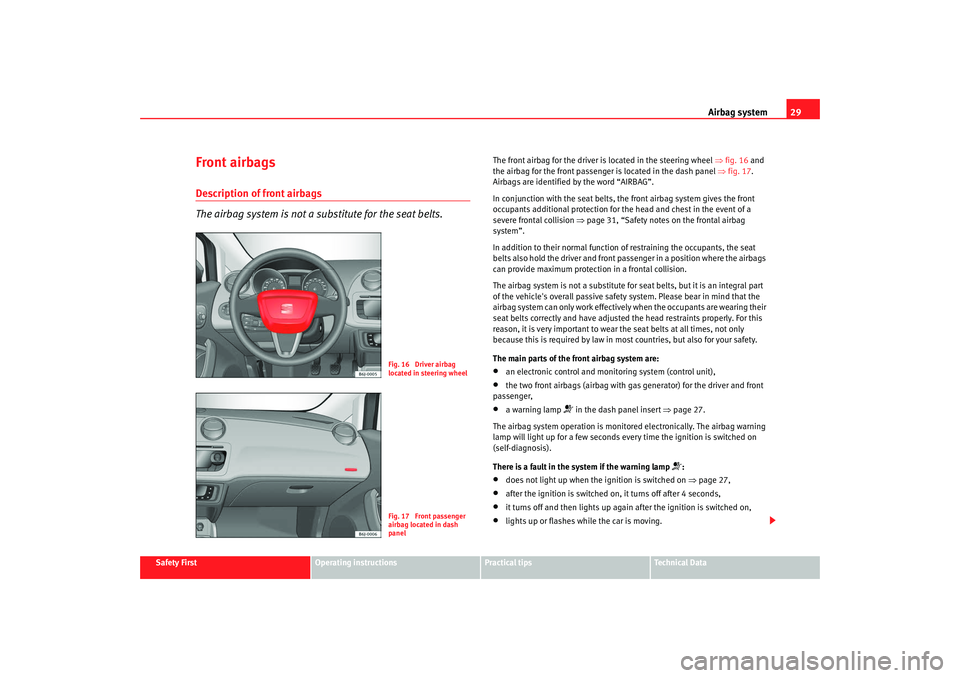
Airbag system29
Safety First
Operating instructions
Practical tips
Te c h n i c a l D a t a
Front airbagsDescription of front airbags
The airbag system is not a substitute for the seat belts.
The front airbag for the driver is located in the steering wheel ⇒fig. 16 and
the airbag for the front passenger is located in the dash panel ⇒fig. 17 .
Airbags are identified by the word “AIRBAG”.
In conjunction with the seat belts, the front airbag system gives the front
occupants additional protection for the head and chest in the event of a
severe frontal collision ⇒page 31, “Safety notes on the frontal airbag
system”.
In addition to their normal function of restraining the occupants, the seat
belts also hold the driver and front pas senger in a position where the airbags
can provide maximum protection in a frontal collision.
The airbag system is not a substitute for seat belts, but it is an integral part
of the vehicle's overall passive safety system. Please bear in mind that the
airbag system can only work effectively when the occupants are wearing their
seat belts correctly and have adjusted the head restraints properly. For this
reason, it is very important to wear the seat belts at all times, not only
because this is required by law in most countries, but also for your safety.
The main parts of the front airbag system are:•
an electronic control and monitoring system (control unit),
•
the two front airbags (airbag with gas generator) for the driver and front
passenger,
•
a warning lamp
in the dash panel insert ⇒page 27.
The airbag system operation is monitored electronically. The airbag warning
lamp will light up for a few seconds every time the ignition is switched on
(self-diagnosis).
There is a fault in the system if the warning lamp
:
•
does not light up when the ignition is switched on ⇒page 27,
•
after the ignition is switched on, it turns off after 4 seconds,
•
it turns off and then lights up again after the ignition is switched on,
•
lights up or flashes while the car is moving.
Fig. 16 Driver airbag
located in steering wheelFig. 17 Front passenger
airbag located in dash
panel
Ibiza250_angles Seite 29 Dienstag, 5. August 2008 1:11 13
Page 33 of 260
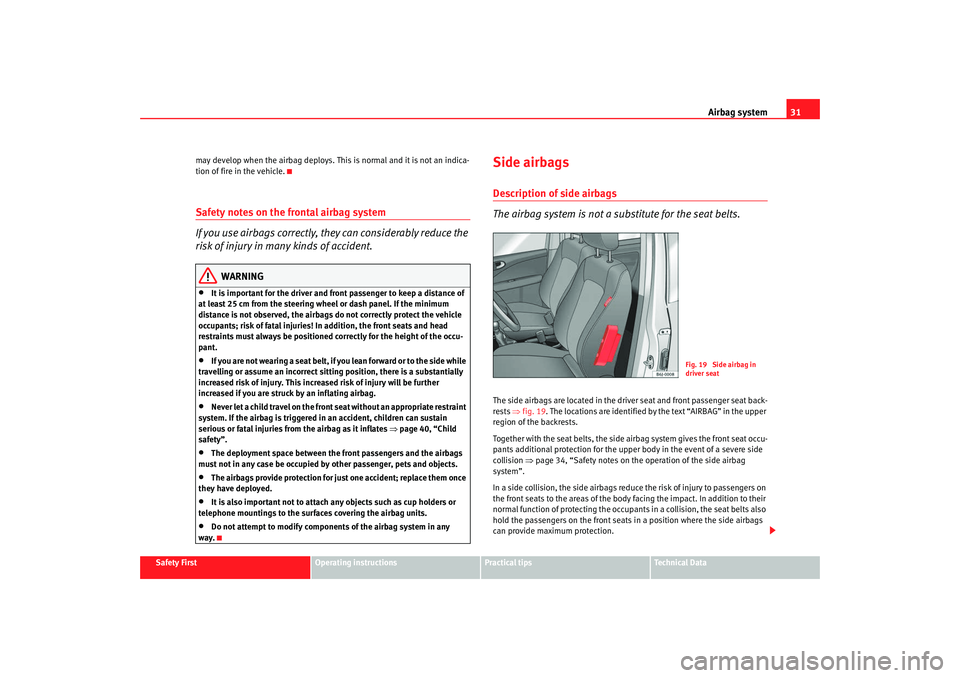
Airbag system31
Safety First
Operating instructions
Practical tips
Te c h n i c a l D a t a
may develop when the airbag deploys. This is normal and it is not an indica-
tion of fire in the vehicle.
Safety notes on the frontal airbag system
If you use airbags correctly, they can considerably reduce the
risk of injury in many kinds of accident.
WARNING
•
It is important for the driver and front passenger to keep a distance of
at least 25 cm from the steering wheel or dash panel. If the minimum
distance is not observed, the airbags do not correctly protect the vehicle
occupants; risk of fatal injuries! In addition, the front seats and head
restraints must always be positioned correctly for the height of the occu-
pant.
•
If you are not wearing a seat belt, if you lean forward or to the side while
travelling or assume an incorrect sitting position, there is a substantially
increased risk of injury. This increased risk of injury will be further
increased if you are struck by an inflating airbag.
•
Never let a child travel on the front seat without an appropriate restraint
system. If the airbag is triggered in an accident, children can sustain
serious or fatal injuries from the airbag as it inflates ⇒page 40, “Child
safety”.
•
The deployment space between the front passengers and the airbags
must not in any case be occupied by other passenger, pets and objects.
•
The airbags provide protection for just one accident; replace them once
they have deployed.
•
It is also important not to attach any objects such as cup holders or
telephone mountings to the surfaces covering the airbag units.
•
Do not attempt to modify components of the airbag system in any
way.
Side airbagsDescription of side airbags
The airbag system is not a substitute for the seat belts.The side airbags are located in the driver seat and front passenger seat back-
rests ⇒fig. 19 . The locations are identified by the text “AIRBAG” in the upper
region of the backrests.
Together with the seat belts, the side airbag system gives the front seat occu-
pants additional protection for the upper body in the event of a severe side
collision ⇒page 34, “Safety notes on the operation of the side airbag
system”.
In a side collision, the side airbags reduce the risk of injury to passengers on
the front seats to the areas of the body facing the impact. In addition to their
normal function of protecting the occupan ts in a collision, the seat belts also
hold the passengers on the front seats in a position where the side airbags
can provide maximum protection.
Fig. 19 Side airbag in
driver seat
Ibiza250_angles Seite 31 Dienstag, 5. August 2008 1:11 13
Page 51 of 260
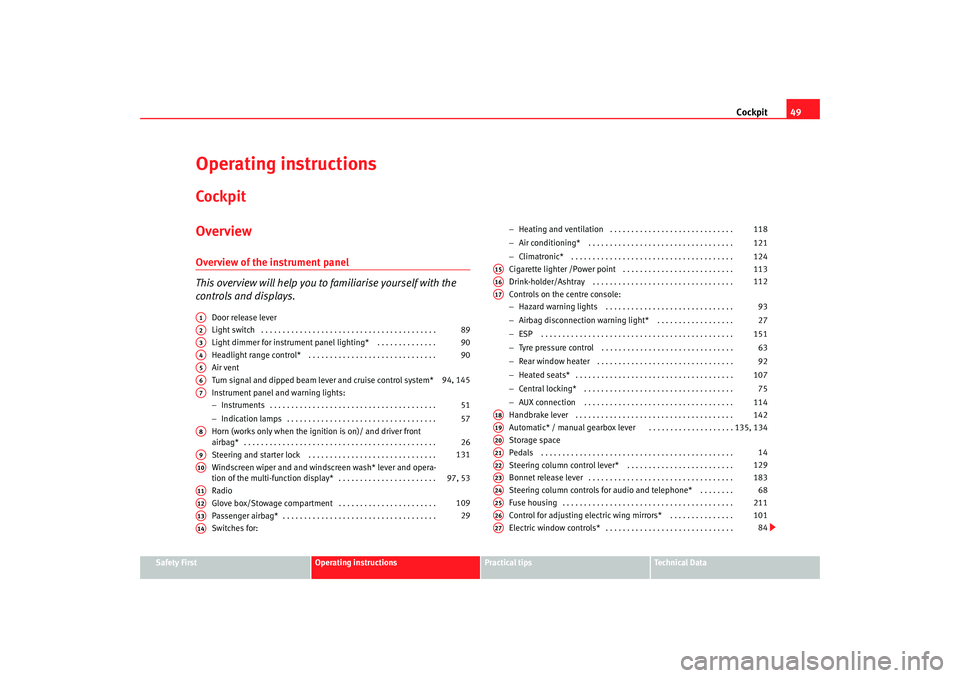
Cockpit49
Safety First
Operating instructions
Practical tips
Te c h n i c a l D a t a
Operating instructionsCockpitOverviewOverview of the instrument panel
This overview will help you to familiarise yourself with the
controls and displays.
Door release lever
Light switch . . . . . . . . . . . . . . . . . . . . . . . . . . . . . . . . . . . . . . . . .
Light dimmer for instrument panel ligh ting* . . . . . . . . . . . . . .
Headlight range control* . . . . . . . . . . . . . . . . . . . . . . . . . . . . . .
Air vent
Turn signal and dipped beam lever and cruise control system*
Instrument panel an d warning lights:
− Instruments . . . . . . . . . . . . . . . . . . . . . . . . . . . . . . . . . . . . . . .
− Indication lamps . . . . . . . . . . . . . . . . . . . . . . . . . . . . . . . . . . .
Horn (works only when the igni tion is on)/ and driver front
airbag* . . . . . . . . . . . . . . . . . . . . . . . . . . . . . . . . . . . . . . . . . . . . .
Steering and starter lock . . . . . . . . . . . . . . . . . . . . . . . . . . . . . .
Windscreen wiper and and windscreen wash* lever and opera-
tion of the multi-function display* . . . . . . . . . . . . . . . . . . . . . . .
Radio
Glove box/Stowage compartment . . . . . . . . . . . . . . . . . . . . . . .
Passenger airbag* . . . . . . . . . . . . . . . . . . . . . . . . . . . . . . . . . . . .
Switches for: −
Heating and ventilation . . . . . . . . . . . . . . . . . . . . . . . . . . . . .
− Air conditioning* . . . . . . . . . . . . . . . . . . . . . . . . . . . . . . . . . .
− Climatronic* . . . . . . . . . . . . . . . . . . . . . . . . . . . . . . . . . . . . . .
Cigarette lighter /Power point . . . . . . . . . . . . . . . . . . . . . . . . . .
Drink-holder/Ashtray . . . . . . . . . . . . . . . . . . . . . . . . . . . . . . . . .
Controls on the centre console:
− Hazard warning lights . . . . . . . . . . . . . . . . . . . . . . . . . . . . . .
− Airbag disconnection warni ng light* . . . . . . . . . . . . . . . . . .
− ESP . . . . . . . . . . . . . . . . . . . . . . . . . . . . . . . . . . . . . . . . . . . . .
− Tyre pressure control . . . . . . . . . . . . . . . . . . . . . . . . . . . . . . .
− Rear window heater . . . . . . . . . . . . . . . . . . . . . . . . . . . . . . . .
− Heated seats* . . . . . . . . . . . . . . . . . . . . . . . . . . . . . . . . . . . . .
− Central locking* . . . . . . . . . . . . . . . . . . . . . . . . . . . . . . . . . . .
− AUX connection . . . . . . . . . . . . . . . . . . . . . . . . . . . . . . . . . . .
Handbrake lever . . . . . . . . . . . . . . . . . . . . . . . . . . . . . . . . . . . . .
A utomatic* / manual gearbox lever
. . . . . . . . . . . . . .
. . . . . .
Storage space
Pedals . . . . . . . . . . . . . . . . . . . . . . . . . . . . . . . . . . . . . . . . . . . . .
Steering column control lever* . . . . . . . . . . . . . . . . . . . . . . . . .
Bonnet release lever . . . . . . . . . . . . . . . . . . . . . . . . . . . . . . . . . .
Steering column controls for audio and telephone* . . . . . . . .
Fuse housing . . . . . . . . . . . . . . . . . . . . . . . . . . . . . . . . . . . . . . . .
Control for adjusting electric wing mirrors* . . . . . . . . . . . . . . .
Electric window controls* . . . . . . . . . . . . . . . . . . . . . . . . . . . . . .
A1A2
89
A3
90
A4
90
A5A6
94, 145
A7
51
57
A8
26
A9
131
A10
97, 53
A11A12
109
A13
29
A14
118
121
124
A15
113
A16
112
A17
93
27
151 63
92
107 75
114
A18
142
A19
135, 134
A20A21
14
A22
129
A23
183
A24
68
A25
211
A26
101
A27
84
Ibiza250_angles Seite 49 Dienstag, 5. August 2008 1:11 13